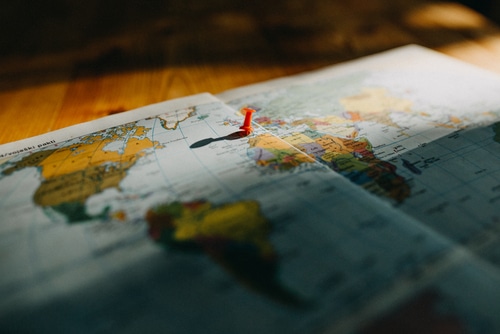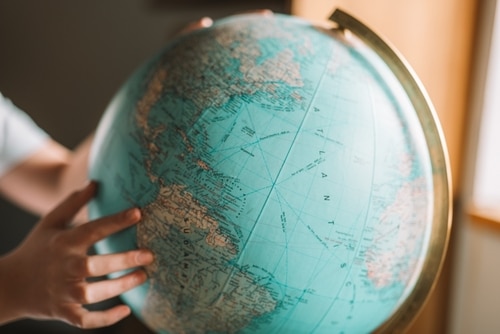Have you ever tried to count how many countries there are in the world, then realized even Google can’t give you a straight answer? Is it 193? 195? 197? The world is full of surprises: tiny countries with big voices, places that operate like nations but aren’t officially recognized, and even a city-state led by a pope. Every country has its own story, and together, they paint a picture of our global community in 2025.
At Remitly, we understand how life across borders makes these global questions more than just trivia; they’re part of your experience. That’s why we’re here to break it all down. Our article covers UN member states, countries by continent, and fun facts about the world in 2025.
The 197 countries explained
Let’s talk numbers: 197, to be exact. That’s the widely accepted total when counting the countries of the world in 2025. It includes UN member states, UN observer states, countries that are recognized but not official UN members, and a few places with unique situations.
UN member countries
At the heart of the global community are the 193 UN member countries. These nations are officially recognized by the United Nations, have full voting rights, and play an active role in shaping international decisions.
From global giants like China and the United States to small but mighty nations like Eswatini and Malta, each one has a seat at the table. Even tiny countries like Vanuatu and San Marino are full participants in the global conversation.
Non-member observer states
There are two unique places: Vatican City (Holy See) and Palestine. These are called observer states at the UN. They’re not full members, so they don’t get voting rights, but they still have a voice in discussions and are widely recognized as independent nations.
Vatican City might be small in size, but it has a huge cultural and spiritual presence, especially as the home of the Pope. Palestine has its own government and is recognized by many countries, even though its political status is still evolving. These two nations add important context to our understanding of what defines a country.
Countries by continent in 2025
The world’s 197 countries aren’t just dots on a map, they’re vibrant communities spread across every corner of the globe. Each continent has its own mix of cultures, histories, and languages that make it wonderfully unique.
Africa
Africa takes the lead with 54 countries, making it the most country-rich continent on Earth. From Guinea-Bissau and Burkina Faso to Eswatini and Côte d’Ivoire, each nation adds its own flavor, traditions, and voice to the global stage. With over 3,000 languages spoken, it’s a continent that truly celebrates diversity.
Capitals like Nouakchott in Mauritania and Maseru in Lesotho may not be as well-known as Paris or Tokyo, but they’re every bit as fascinating. Countries like Nigeria are growing fast, not just in population, but in global influence too.
Asia
With 48 countries, Asia is the largest continent both in size and in population. You’ll find major global players like China, India, and Japan, as well as smaller yet equally notable countries like Bhutan, the Maldives, and Timor-Leste.
Asia is home to capitals like Thimphu and Naypyidaw, places filled with history, resilience, and cultural richness. Even in areas with complex political situations, like Taiwan and Palestine, people are building communities and shaping the world in meaningful ways.
Europe
Europe’s 44 countries are packed with variety. You’ve got iconic destinations like France, Germany, and the United Kingdom, alongside fascinating microstates like Monaco, Liechtenstein, and Vatican City.
Countries like Bosnia and Herzegovina and North Macedonia carry deep histories and unique identities shaped by change. Meanwhile, name updates like Czechia replacing the Czech Republic show how Europe continues to evolve while maintaining its strong global presence.
Oceania
Oceania may have just 14 countries, but they’re scattered across some of the world’s most stunning and remote landscapes. From larger nations like Australia and New Zealand to smaller island countries like Tuvalu, Tonga, and Nauru, this region is a mosaic of languages, traditions, and natural beauty.
Capitals like Funafuti, Nukuʻalofa, and Palikir may be less well-known, but they stand proudly as symbols of sovereignty and cultural pride. Many of these countries are leading voices in the fight against climate change and environmental protection.
North America
North America is home to 23 countries, including a mix of powerhouse economies, rich cultural traditions, and a wide range of landscapes. The region includes Canada, the United States, and Mexico, as well as Caribbean nations like Antigua and Barbuda, St. Kitts and Nevis, and St. Vincent and the Grenadines.
South America
South America brings together 12 countries known for their natural wonders, passionate cultures, and growing global roles. From the Amazon rainforest to the Andes mountains, this continent is rich in biodiversity and deeply rooted traditions.

Population and global influence predictions for 2025
A lot can change in a few years, and when it comes to population and power, 2025 is already shaping up to be an interesting chapter in global history.
Estimated global population
As of January 2025, the world’s population has grown to over 8.1 billion people. That’s a huge milestone and reflects incredible growth, especially in countries across Africa and Asia. Cities are expanding, new opportunities are emerging, and people are more connected than ever.
With this growth comes challenges and new possibilities, like greater demand for jobs, housing, education, and healthcare. But it also means more innovation, more dynamic communities, and a stronger global network. Every new person adds something special to the shared story of our planet.
Most populous countries
India currently takes the top spot as the world’s most populous country, overtaking China for the first time. Following close behind are the United States, Indonesia, and Pakistan.
Each of these nations brings something unique to the table. India’s booming tech industry is making waves around the world. China remains a powerhouse in manufacturing and infrastructure. Meanwhile, Indonesia is rapidly becoming a major economic and cultural force in Southeast Asia.
Projections of the most powerful country
When we talk about “power” on the world stage, we’re usually looking at a mix of factors: economy, military strength, diplomacy, and culture. In 2025, most experts agree that China, the United States, and Russia are the biggest players in that space.
Their influence can be seen in economics, technology, global partnerships, and beyond. But other countries like Germany, the United Kingdom, and France aren’t to be overlooked, leading with strong voices in international affairs. Even smaller nations like Singapore and Qatar are stepping up, using innovation, finance, and strategic diplomacy to increase their global impact.
Interesting facts about selected countries
Every country has its unique charm, whether it’s a tiny capital city you’ve not heard of or a nation that doesn’t always appear on official lists.
Notable facts and trivia
- Vatican City is the smallest country in the world, with fewer than 1,000 residents. Despite its size, it has its own post office, radio station, currency, and even an ATM in Latin.
- Australia is the only country that’s also an entire continent, home to the largest coral reef system in the world.
- San Marino, one of the world’s oldest republics, has been an independent state since 301 AD.
- Bhutan measures national success not by GDP, but Gross National Happiness.
- Monaco has the highest population density of any country and offers zero income tax for residents.
- Iceland runs almost entirely on renewable energy, with geothermal and hydropower sources powering homes, schools, and even public pools.
- Japan consists of over 6,800 islands and features some of the fastest trains on the planet.
- Namibia is home to some of the world’s oldest deserts, and it was the first country to include environmental protection in its constitution.
- Chile stretches over 2,600 miles from north to south, making it one of the longest countries in the world.
Recognized and partially recognized states
Some places aren’t always officially recognized but still feel like full countries to the people who call them home. For example:
- Taiwan has its own government, a thriving economy, and bustling cities, but it isn’t a UN member due to complex diplomatic relationships.
- Kosovo declared independence in 2008 and is recognized by over 100 countries.
- Other regions like Western Sahara, Northern Cyprus, and South Ossetia exist in unique political situations and may or may not be recognized by all governments.
Can the number of countries change?
The world map isn’t static. New countries can emerge, names can change, and borders can shift as history unfolds. For example, South Sudan became the newest country in 2011 after gaining independence from Sudan.
That’s why it’s wise to check trusted sources if you’re curious about the latest country counts. Resources like the UN Member States list, the CIA World Factbook, and ISO Country Codes are great places to stay informed. After all, part of being globally aware is knowing that change is always on the horizon, and that’s what keeps things interesting.
Immigration and why country status matters
When you’re planning a move, applying for a visa, or simply sending money to your family back home, the world map isn’t just borders and labels, it can shape your real-life journey. From paperwork to payments, country status can influence how smoothly things go.
Visa and travel eligibility
Getting a visa or travel documentation often depends on formal recognition between countries. If your country isn’t officially recognized by another, it might mean extra paperwork, different routes, or longer processing times.
Checking your home country’s status and how it’s viewed by your destination can help you plan, avoid surprises, and stay confident throughout the process. It’s all about being one step ahead.
Sending and receiving money
Most money transfer services rely on official country lists to process transactions securely. So if you’re sending money to a region with limited recognition, it’s worth checking that the country is supported. Sometimes, alternative transfer options are available, but knowing the details up front helps you choose the safest and most efficient way to send funds.
Access to services abroad
Once you arrive in your new country, your journey doesn’t stop there. Your home country’s recognition status can continue to affect important aspects of daily life, like how your passport is received, and whether your degree, driving license, or other documents are accepted.
In some cases, people from disputed or unrecognized regions face extra steps when opening a bank account, enrolling in school, or accessing healthcare. That’s why it pays to be informed before you make a move. With a little preparation, you can confidently navigate these systems and settle into your new home more smoothly.
FAQs
How many countries are there in the world in 2025?
There are 197 recognized countries: 193 UN members, 2 observer states, and 2 widely recognized independent nations.
Why do some sources say there are 256 countries?
That number includes territories and dependencies, not just fully independent countries.
What’s the world population in 2025?
As of January 2025, it’s just over 8.1 billion people.
Which countries are the most powerful in 2025?
The United States, China, and Russia lead globally, with growing influence from countries like Germany and the UK.
Which country will be the most populous in 2025?
India is currently number 1, followed by China, the United States, Indonesia, and Pakistan.
